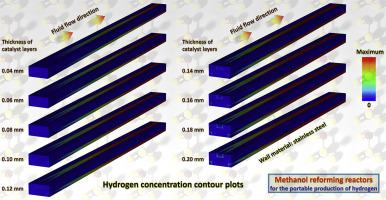International Journal of Hydrogen Energy ( IF 7.2 ) Pub Date : 2020-05-23 , DOI: 10.1016/j.ijhydene.2020.04.128 Junjie Chen , Tengfei Li , Fanmao Meng , Pingmei Ming

|
Ignoring possible effects due to intraphase diffusion within catalyst layers is a common feature of computational fluid dynamics models developed for reforming microchannel reactors. Resistance to diffusion within the catalyst layers applied to such a reactor is often ignored on the grounds that the catalyst layers are sufficiently thin to allow reactants unrestricted access to all available reaction sites. However, this assumption is not necessarily correct, and intraphase diffusion effects could be important. Three-dimensional numerical simulations were carried out using computational fluid dynamics to investigate the characteristics of intraphase transport processes within the catalyst layers arranged in a thermally integrated methanol reforming microchannel reactor. The heat and mass transfer effects involved in the reforming process were evaluated, and the optimum thickness of catalyst layers was determined for the reactor. Particular focus was placed on how to optimize the thickness of catalyst layers in order to operate the reactor more efficiently. The results indicated that the performance of the reactor can be greatly improved by means of proper design of catalyst layer thickness to enhance heat and mass transfer into the catalyst layers. The thickness of the catalyst layers can be optimized to minimize diffusional resistance while maximizing methanol conversion and hydrogen yield. Thick catalyst layers offer higher reactor performance, whereas thin catalyst layers improve catalyst utilization and thermal uniformity. The thickness scale at which intraphase diffusion effects become noticeable was finally determined on the basis of reactor performance. The critical thickness was found to be about 0.10 mm, and catalyst layers should be designed beyond this dimension to achieve the desired level of conversion. The critical thickness will vary depending upon layer properties and operating conditions.
中文翻译:

甲醇重整微通道反应器内相输运过程的特征:计算流体动力学研究
忽略由于催化剂层内的内相扩散而可能产生的影响是为重整微通道反应器而开发的计算流体动力学模型的共同特征。由于催化剂层足够薄以至于允许反应物不受限制地进入所有可用的反应位置,因此常常忽略了应用于这种反应器的催化剂层内的扩散阻力。但是,此假设不一定正确,并且相内扩散效应可能很重要。使用计算流体动力学进行了三维数值模拟,以研究在热集成甲醇重整微通道反应器中布置的催化剂层内的相内传输过程的特征。评估了重整过程中的传热和传质效果,并确定了反应器的最佳催化剂层厚度。特别着重于如何优化催化剂层的厚度以便更有效地操作反应器。结果表明,通过适当设计催化剂层厚度以增强热量和质量传递到催化剂层中,可以大大提高反应器的性能。可以优化催化剂层的厚度以最小化扩散阻力,同时最大化甲醇转化率和氢产率。较厚的催化剂层可提供更高的反应器性能,而较薄的催化剂层可提高催化剂利用率和热均匀性。最后根据反应器性能确定相内扩散作用变得明显的厚度尺度。发现临界厚度为约0.10mm,并且催化剂层应设计成超过该尺寸以实现所需的转化水平。临界厚度将根据层的性质和操作条件而变化。

























 京公网安备 11010802027423号
京公网安备 11010802027423号